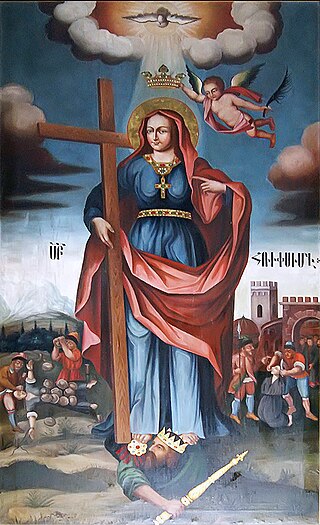Related Research Articles

Timothy or Timothy of Ephesus was an early Christian evangelist and the first Christian bishop of Ephesus, who tradition relates died around the year AD 97.
Pope Evaristus was the bishop of Rome from c. 99 to his death c. 107. He was also known as Aristus and is venerated as a saint in the Eastern Orthodox Church, the Catholic Church, and Oriental Orthodoxy. It is likely that John the Apostle died during his reign period, marking the end of the Apostolic Age.

A martyr is someone who suffers persecution and death for advocating, renouncing, or refusing to renounce or advocate, a religious belief or other cause as demanded by an external party.
Pope Marcellinus was the bishop of Rome from 30 June 296 to his death in 304. A historical accusation was levelled at him by some sources to the effect that he might have renounced Christianity during Emperor Diocletian's persecution of Christians before repenting afterwards, which would explain why he is omitted from lists of martyrs. The accusation is rejected, among others, by Augustine of Hippo. He is today venerated as a saint in the Catholic Church and in the Serbian Orthodox Church.

The Passion of Saints Perpetua and Felicity is a diary by Vibia Perpetua describing her imprisonment as a Christian in 203, completed after her death by a redactor. It is one of the oldest and most notable early Christian texts.

Blaise of Sebaste was a physician and bishop of Sebastea in historical Armenia who is venerated as a Christian saint and martyr.

José Luis Sánchez del Río was a Mexican Cristero who was put to death by government officials because he refused to renounce his Catholic faith. His death was seen as a largely political venture on the part of government officials in their attempt to stamp out dissent and crush religious freedom in the area. He was dubbed "Joselito."

Pancras was a Roman citizen who converted to Christianity and was beheaded for his faith at the age of fourteen, around the year 304. His name is Greek (Παγκράτιος) and means "the one that holds everything".
Pedro Calungsod, also known as Peter Calungsod and Pedro Calonsor, was a Catholic Filipino-Visayan migrant, sacristan and missionary catechist who, along with the Spanish Jesuit missionary Diego Luis de San Vitores, suffered religious persecution and martyrdom in Guam for their missionary work in 1672.

Saint Blandina was a Christian martyr who died in Lugdunum during the reign of Emperor Marcus Aurelius.

Euphemia, known as the All-praised in the Eastern Orthodox Church, was a virgin, who was martyred for her faith at Chalcedon in 303 AD.

Alexander of Jerusalem was a third century bishop who is venerated as a martyr and saint by the Eastern Orthodox Church, Oriental Orthodox churches, and the Roman Catholic Church. He died during the persecution of Emperor Decius.

Justus and Pastor, venerated as Christian martyrs, were two schoolboy brothers who were killed for their faith during the Diocletian persecutions. The boys are today considered the patron saints of Alcalá. They are mentioned by Prudentius.

Saints Cyprian and Justina are honored in the Catholic Church, Eastern Orthodox Church and Oriental Orthodoxy as Christians of Antioch, who in 304, during the Diocletianic Persecution, suffered martyrdom at Nicomedia on September 26. According to Roman Catholic sources, no Bishop of Antioch bore the name of Cyprian.

Agapitus is venerated as a martyr saint, who died on August 18, perhaps in 274, a date that the latest editions of the Roman Martyrology say is uncertain.

Hripsime, also called Rhipsime, Ripsime, Ripsima, Ripsimia, Ripsimus, Arbsima or Arsema was a martyr of Roman origin; she and her companions in martyrdom are venerated as some of the first Christian martyrs of Armenia.

Damnatio ad bestias was a form of Roman capital punishment where the condemned person was killed by wild animals, usually lions or other big cats. This form of execution, which first appeared during the Roman Republic around the 2nd century BC, had been part of a wider class of blood sports called Bestiarii.

Saint Timolaus and five companions, according to the historian of the early Christian church Eusebius in his Martyrs of Palestine, were young men who, having heard that the Roman authorities in Caesarea, Palestine, in 303 AD, had condemned a number of Christians to die by being thrown to wild beasts in the public arena, came before the governor of their own volition with their hands tied behind their backs and demanded to join their fellow Christians in that martyrdom. They were not however thrown to wild beasts but decapitated along with two other men who were already in prison.

Perpetua and Felicity were Christian martyrs of the 3rd century. Vibia Perpetua was a recently married, well-educated noblewoman, said to have been 22 years old at the time of her death, and mother of an infant son she was nursing. Felicity, an enslaved woman imprisoned with her and pregnant at the time, was martyred with her. They were put to death along with others at Carthage in the area of Africa in the Roman province of Africa.

The Martyrdom of Saint Erasmus is an altarpiece, painted by Nicolas Poussin in 1628–1629, originally displayed in St. Peter's Basilica, Rome.
References
- ↑ St. Germanicus Catholic Online
- ↑ Page 653 A Dictionary of Christian Biography, Literature, Sects and Doctrines